ALMA Observations of G333.6-0.2: Molecular and Ionized Gas Environment
Abstract
1. Introduction
2. Observations
3. Molecular Gas Environment
4. Rotation Diagram Analysis: Estimation of Gas Temperature
5. Radio Recombination Lines: H29 and He29
6. Properties of the H ii Region
7. Conclusions
Author Contributions
Funding
Data Availability Statement
Conflicts of Interest
Abbreviations
References
- Tan, J.C.; Beltrán, M.T.; Caselli, P.; Fontani, F.; Fuente, A.; Krumholz, M.R.; McKee, C.F.; Stolte, A. Massive Star Formation. In Protostars and Planets VI; Beuther, H., Klessen, R.S., Dullemond, C.P., Henning, T., Eds.; University of Arizona Press: Baltimore, MD, USA, 2014; pp. 149–172. [Google Scholar] [CrossRef]
- van Dishoeck, E.F.; Blake, G.A. Chemical Evolution of Star-Forming Regions. Annu. Rev. Astron. Astrophys. 1998, 36, 317–368. [Google Scholar] [CrossRef] [PubMed]
- Cesaroni, R.; Hofner, P.; Araya, E.; Kurtz, S. The structure of hot molecular cores over 1000 AU. Astron. Astrophys. 2010, 509, A50. [Google Scholar] [CrossRef]
- Bonfand, M.; Belloche, A.; Menten, K.M.; Garrod, R.T.; Müller, H.S.P. Exploring molecular complexity with ALMA (EMoCA): Detection of three new hot cores in Sagittarius B2(N). Astron. Astrophys. 2017, 604, A60. [Google Scholar] [CrossRef]
- Keto, E.; Wood, K. Observations on the Formation of Massive Stars by Accretion. Astrophys. J. 2006, 637, 850–859. [Google Scholar] [CrossRef]
- Kurtz, S.; Cesaroni, R.; Churchwell, E.; Hofner, P.; Walmsley, C.M. Hot Molecular Cores and the Earliest Phases of High-Mass Star Formation. In Protostars and Planets IV; Mannings, V., Boss, A.P., Russell, S.S., Eds.; University of Arizona Press: Baltimore, MD, USA, 2000; pp. 299–326. [Google Scholar]
- Goss, W.M.; Shaver, P.A. Galactic Radio Sources I: High Resolution 5000 MHz observations. Aust. J. Phys. Astrophys. Suppl. 1970, 14, 1. [Google Scholar]
- Fujiyoshi, T.; Smith, C.H.; Caswell, J.L.; Moore, T.J.T.; Lumsden, S.L.; Aitken, D.K.; Roche, P.F. Radio and infrared recombination studies of the southern massive star forming region G333.6-0.2. Mon. Not. R. Astron. Soc. 2006, 368, 1843–1855. [Google Scholar] [CrossRef]
- Grave, J.M.C.; Kumar, M.S.N.; Ojha, D.K.; Teixeira, G.D.C.; Pace, G. The ionizing sources of luminous compact HII regions in the RCW106 and RCW122 clouds. Astron. Astrophys. 2014, 563, A123. [Google Scholar] [CrossRef][Green Version]
- Conti, P.S.; Crowther, P.A. MSX mid-infrared imaging of massive star birth environments - II. Giant HII regions. Mon. Not. R. Astron. Soc. 2004, 355, 899–917. [Google Scholar] [CrossRef]
- Fujiyoshi, T.; Smith, C.H.; Moore, T.J.T.; Aitken, D.K.; Roche, P.F.; Quinn, D.E. 12-μm fine-structure emission line and continuum images of G333.6-0.2. Mon. Not. R. Astron. Soc. 1998, 296, 225–230. [Google Scholar] [CrossRef][Green Version]
- Kumar, M.S.N. Radiatively driven Rayleigh-Taylor instability candidates around a forming massive star system. NACO adaptive optics and VISIR study of G333.6-0.2. Astron. Astrophys. 2013, 558, A119. [Google Scholar] [CrossRef]
- Mookerjea, B.; Kramer, C.; Nielbock, M.; Nyman, L.Å. The Giant Molecular Cloud associated with RCW 106. A 1.2 mm continuum mapping study. Astron. Astrophys. 2004, 426, 119–129. [Google Scholar] [CrossRef]
- McMullin, J.P.; Waters, B.; Schiebel, D.; Young, W.; Golap, K. CASA Architecture and Applications. In Proceedings of the Astronomical Data Analysis Software and Systems XVI, Tucson, AZ, USA, 15–18 October 2017; Astronomical Society of the Pacific Conference Series. Shaw, R.A., Hill, F., Bell, D.J., Eds.; Astronomical Society of the Pacific: San Francisco, CA, USA, 2007; Volume 376, p. 127. [Google Scholar]
- Astropy Collaboration; Robitaille, T.P.; Tollerud, E.J.; Greenfield, P.; Droettboom, M.; Bray, E.; Aldcroft, T.; Davis, M.; Ginsburg, A.; Price-Whelan, A.M.; et al. Astropy: A community Python package for astronomy. Astron. Astrophys. 2013, 558, A33. [Google Scholar] [CrossRef]
- Bonfand, M.; Csengeri, T.; Bontemps, S.; Brouillet, N.; Motte, F.; Louvet, F.; Ginsburg, A.; Cunningham, N.; Galván-Madrid, R.; Herpin, F.; et al. ALMA-IMF. XI. The sample of hot core candidates: A rich population of young high-mass protostars unveiled by the emission of methyl formate. Astron. Astrophys. 2024, 687, A163. [Google Scholar] [CrossRef]
- Csengeri, T.; Bontemps, S.; Wyrowski, F.; Megeath, S.T.; Motte, F.; Sanna, A.; Wienen, M.; Menten, K.M. The ATLASGAL survey: The sample of young massive cluster progenitors. Astron. Astrophys. 2017, 601, A60. [Google Scholar] [CrossRef]
- Motte, F.; Bontemps, S.; Csengeri, T.; Pouteau, Y.; Louvet, F.; Stutz, A.M.; Cunningham, N.; López-Sepulcre, A.; Brouillet, N.; Galván-Madrid, R.; et al. ALMA-IMF. I. Investigating the origin of stellar masses: Introduction to the Large Program and first results. Astron. Astrophys. 2022, 662, A8. [Google Scholar] [CrossRef]
- Komesh, T.; Omar, A.; Garay, G.; Assembay, Z.; Alimgazinova, N.; Zhumabay, N.; Kyzgarina, M. ALMA observations of the environments of G333.0162+00.7615. In Proceedings of the Resolving the Rise and Fall of Star Formation in Galaxies, Busan, Republic of Korea, 9 June 2023; Wong, T., Kim, W.T., Eds.; IAU Symposium. Cambridge University Press: Cambridge, UK, 2023; Volume 373, pp. 35–38. [Google Scholar] [CrossRef]
- Assembay, Z.; Komesh, T.; Garay, G.; Omar, A.; Esimbek, J.; Alimgazinova, N.; Kyzgarina, M.; Murat, S. ALMA observations of the environments of G301.1364-00.2249A. In Proceedings of the Cosmic Masers: Proper Motion Toward the Next-Generation Large Projects, Kagoshima, Japan, 20–24 March 2023; Hirota, T., Imai, H., Menten, K., Pihlström, Y., Eds.; IAU Symposium. Cambridge University Press: Cambridge, UK, 2024; Volume 380, pp. 204–206. [Google Scholar] [CrossRef]
- Martín, S.; Martín-Pintado, J.; Blanco-Sánchez, C.; Rivilla, V.M.; Rodríguez-Franco, A.; Rico-Villas, F. Spectral Line Identification and Modelling (SLIM) in the MAdrid Data CUBe Analysis (MADCUBA) package. Interactive software for data cube analysis. Astron. Astrophys. 2019, 631, A159. [Google Scholar] [CrossRef]
- Komesh, T.; Garay, G.; Henkel, C.; Omar, A.; Estalella, R.; Assembay, Z.; Li, D.; Guzmán, A.; Esimbek, J.; Huang, J.; et al. Infall Motions in the Hot Core Associated with the Hypercompact H II Region G345.0061+01.794 B. Astrophys. J. 2024, 967, 15. [Google Scholar] [CrossRef]
- Roelfsema, P.R.; Goss, W.M. High resolution radio recombination line observations. Astron. Astrophys. Rev. 1992, 4, 161–214. [Google Scholar] [CrossRef]
- Méndez-Delgado, J.E.; Esteban, C.; García-Rojas, J.; Arellano-Córdova, K.Z.; Valerdi, M. Helium abundances and its radial gradient from the spectra of H II regions and ring nebulae of the Milky Way. Mon. Not. R. Astron. Soc. 2020, 496, 2726–2742. [Google Scholar] [CrossRef]
- Gordon, M.A.; Sorochenko, R.L. Radio Recombination Lines: Their Physics and Astronomical Applications; Springer: Berlin/Heidelberg, Germany, 2002; Volume 282. [Google Scholar]
- Wilson, T.L.; Rohlfs, K.; Hüttemeister, S. Tools of Radio Astronomy; Springer: Berlin/Heidelberg, Germany, 2009. [Google Scholar] [CrossRef]
- Shi, H.; Zhao, J.H.; Han, J.L. Nature of W51e2: Massive Cores at Different Phases of Star Formation. Astrophys. J. 2010, 710, 843–852. [Google Scholar] [CrossRef]
- Manapbayeva, A.; Omar, A.; Alimgazinova, N.; Komesh, T.; Kyzgarina, M.; Esimbek, J.; Assembay, Z. Determination of physical parameters of the W40 HII region using observations of H110α radio recombination line. Rec. Contr. Phys. 2023, 86, 4–11. [Google Scholar] [CrossRef]
- Rubin, R.H. A Discussion of the Sizes and Excitation of H II Regions. Astrophys. J. 1968, 154, 391. [Google Scholar] [CrossRef]
- Mezger, P.G.; Smith, L.F.; Churchwell, E. IR-excess Radiation and the Absorption Characteristics of Dust in Galactic H II Regions. Astron. Astrophys. 1974, 32, 269. [Google Scholar]
- Matsakis, D.N.; Evans, N.J., II; Sato, T.; Zuckerman, B. Radio continuum measurements of compact H II regions and other sources. Astron. J. 1976, 81, 172–177. [Google Scholar] [CrossRef]
- Mehringer, D.M. Radio Continuum and Radio Recombination Line Observations of W51. Astrophys. J. Suppl. 1994, 91, 713. [Google Scholar] [CrossRef]
- Panagia, N. Some Physical parameters of early-type stars. Astron. J. 1973, 78, 929–934. [Google Scholar] [CrossRef]
- Yang, A.Y.; Urquhart, J.S.; Thompson, M.A.; Menten, K.M.; Wyrowski, F.; Brunthaler, A.; Tian, W.W.; Rugel, M.; Yang, X.L.; Yao, S.; et al. A population of hypercompact H II regions identified from young H II regions. Astron. Astrophys. 2021, 645, A110. [Google Scholar] [CrossRef]
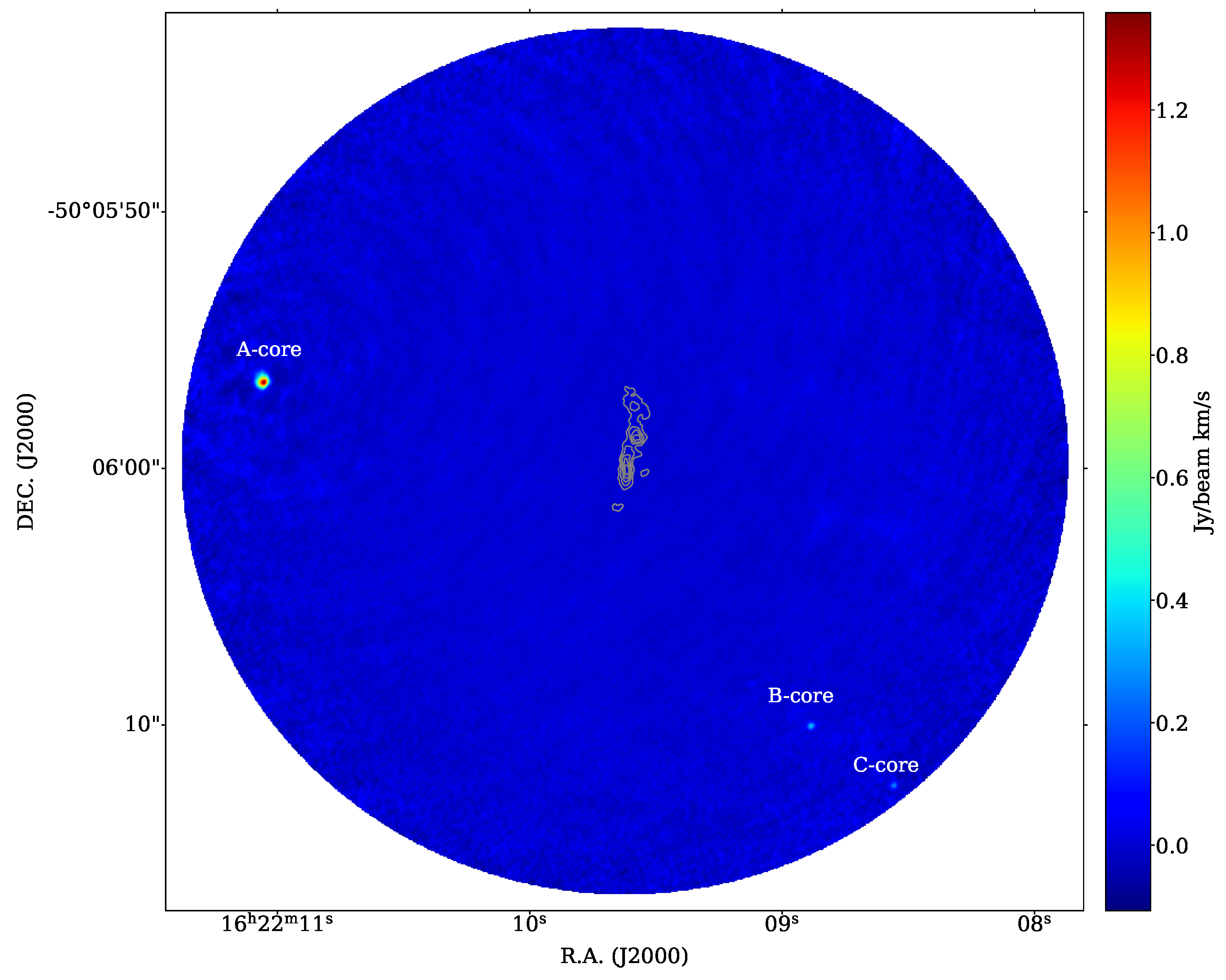
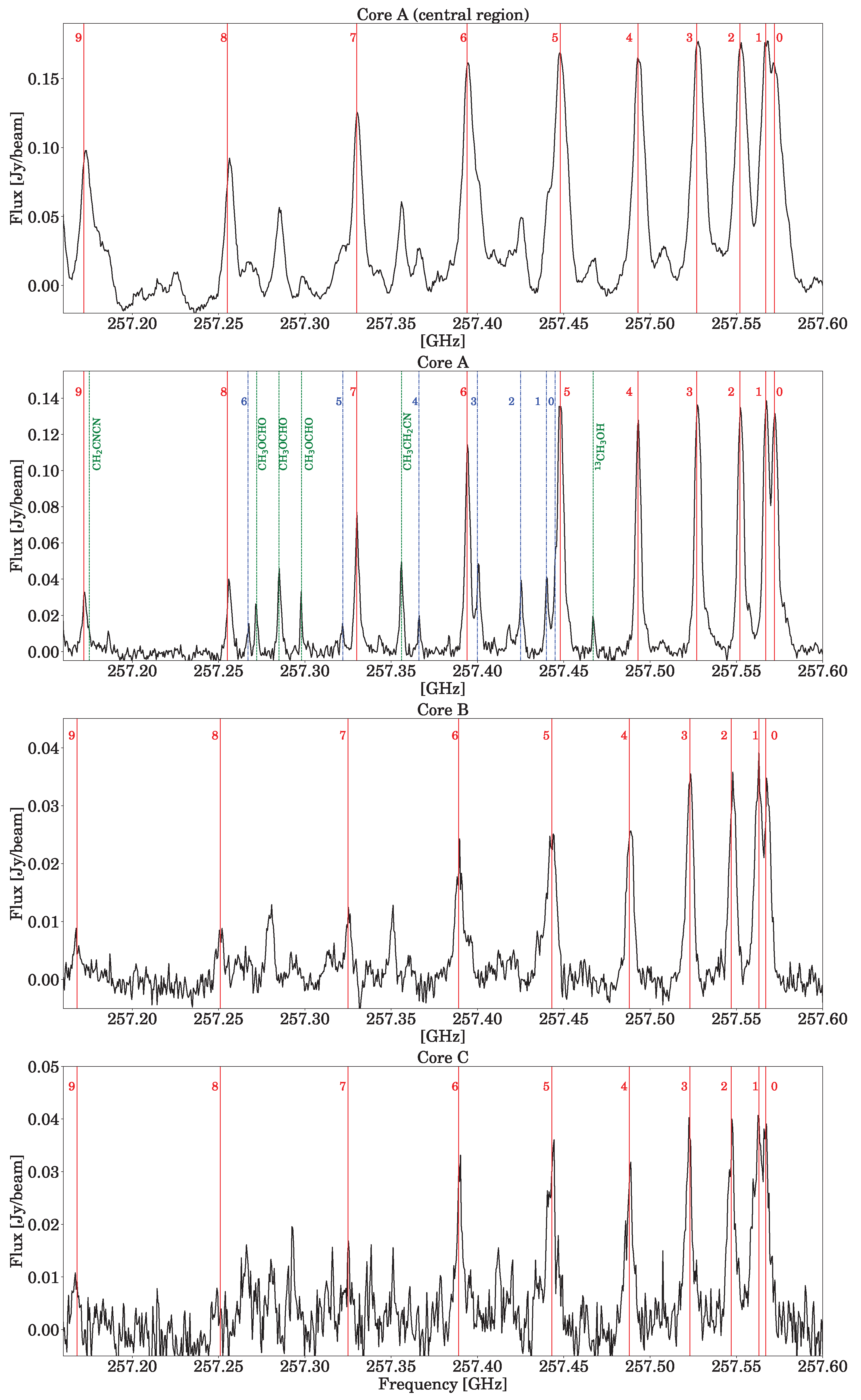

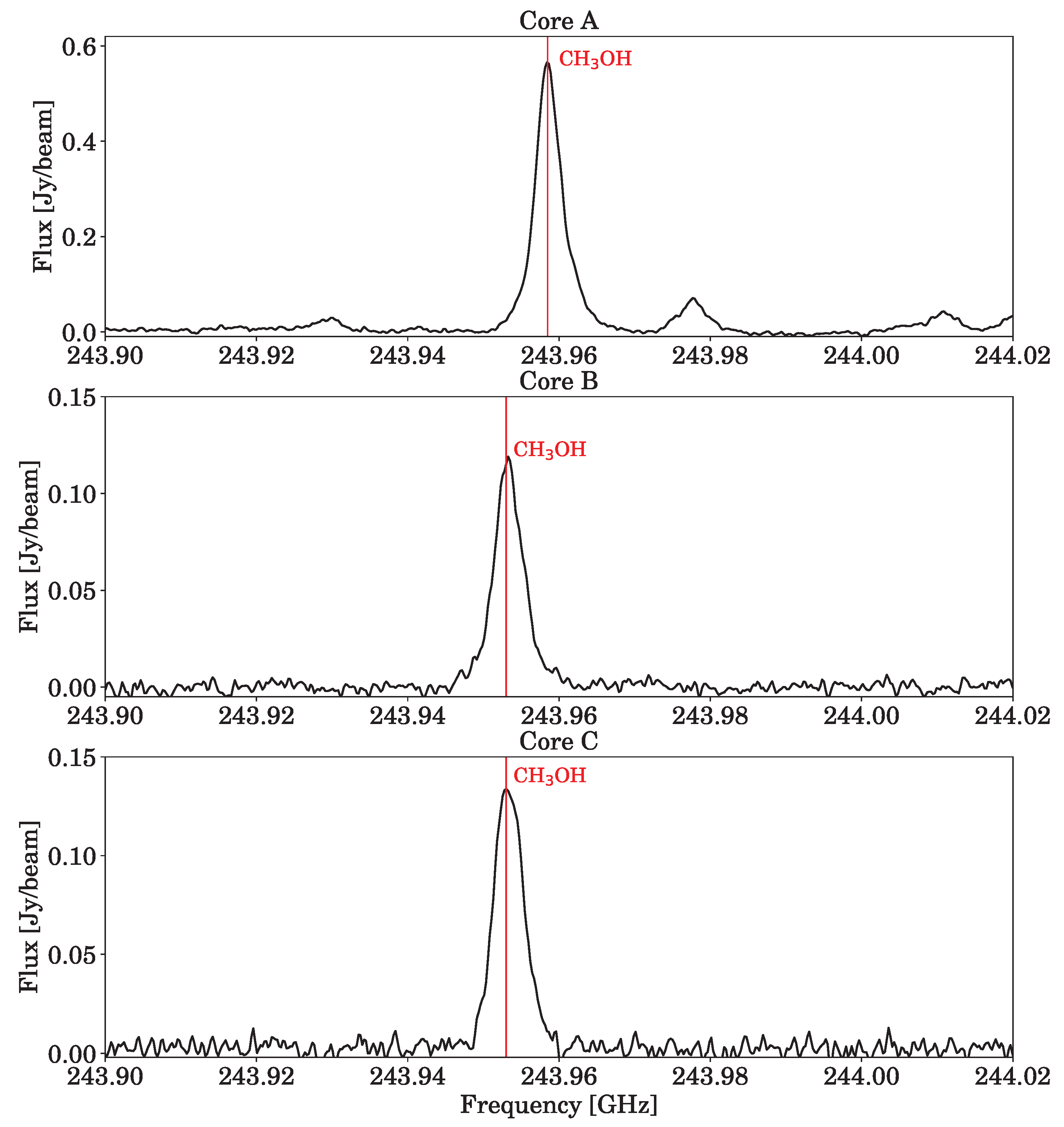


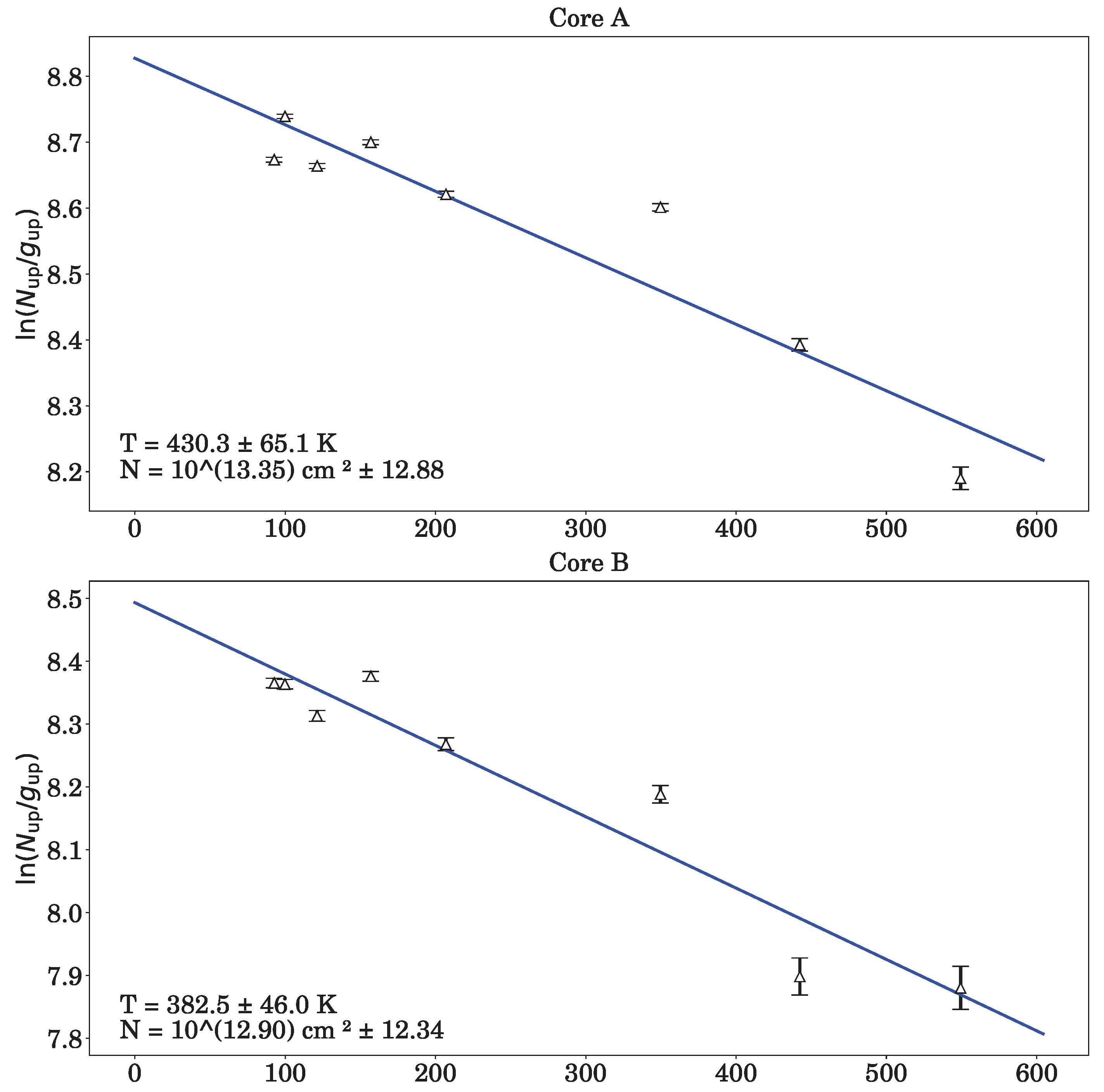

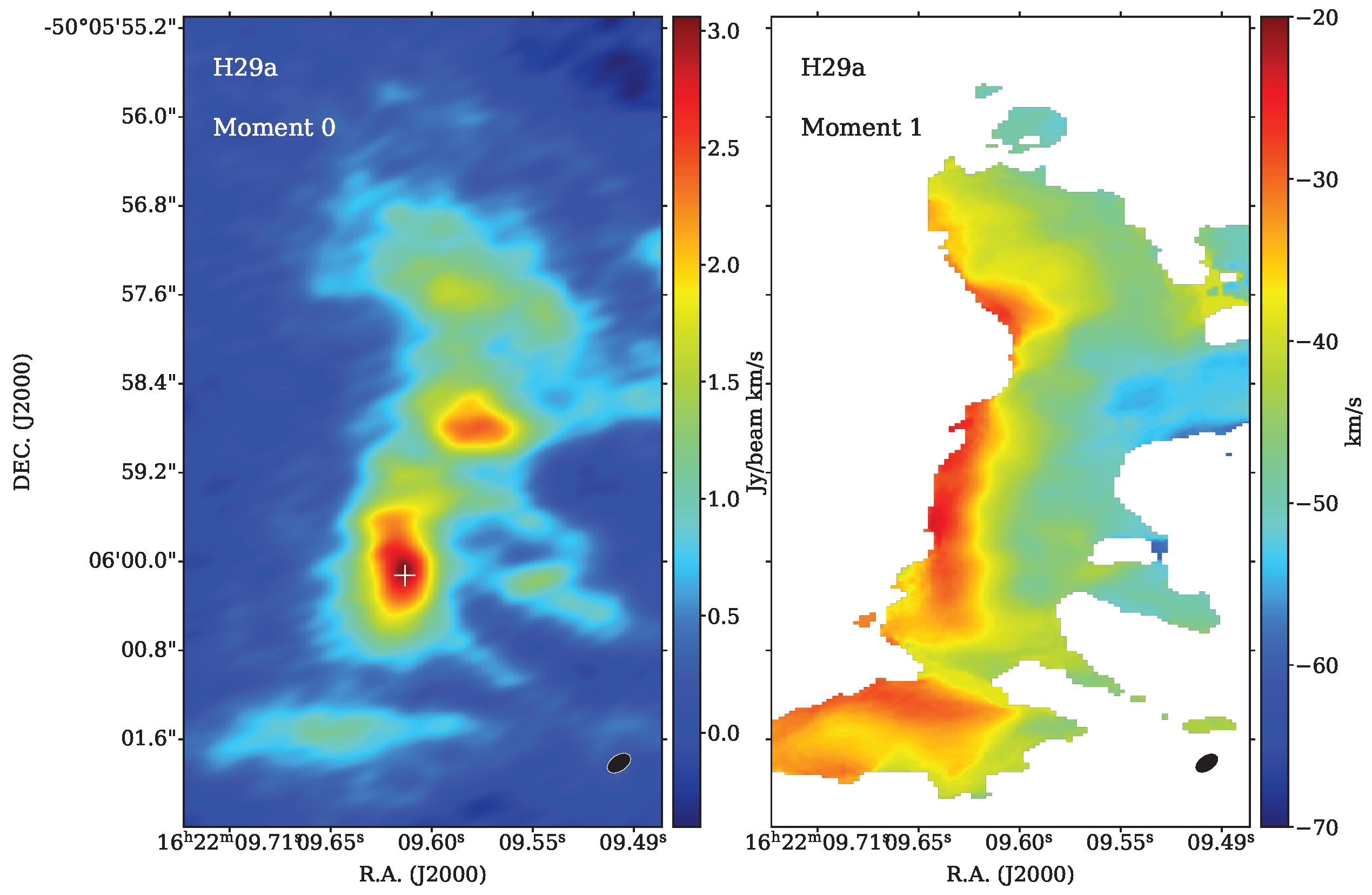
| Core | Coordinates (RA, Dec) | [km s−1] | Sizea [″] | [″] |
|---|---|---|---|---|
| A | (16h 22m 11.061s, 05′56″64) | 0.360 | 0.315 | |
| B | (16h 22m 08.892s, 06′10″03) | 0.237 | 0.162 | |
| C | (16h 22m 08.559s, 06′12″34) | 0.247 | 0.176 |
| Species | Transition | Frequency (GHz) | Eu/k (K) |
|---|---|---|---|
| CH3CN | 140 → 130 | 257.527 | 92.70 |
| 141 → 131 | 257.522 | 99.85 | |
| 142 → 132 | 257.508 | 121.28 | |
| 143 → 133 | 257.483 | 156.99 | |
| 144 → 134 | 257.448 | 206.98 | |
| 145 → 135 | 257.404 | 271.23 | |
| 146 → 136 | 257.349 | 349.72 | |
| 147 → 137 | 257.285 | 442.45 | |
| 148 → 138 | 257.210 | 549.38 | |
| 149 → 139 | 257.127 | 670.50 | |
| CH313CN | 140 → 130, F = 14-13 | 257.400 | 92.65 |
| 141 → 131, F = 14-13 | 257.395 | 99.80 | |
| 142 → 132, F = 14-13 | 257.380 | 121.23 | |
| 143 → 133, F = 14-13 | 257.355 | 156.94 | |
| 144 → 134, F = 14-13 | 257.321 | 206.93 | |
| 145 → 135, F = 14-13 | 257.276 | 271.17 | |
| 146 → 136, F = 14-13 | 257.222 | 349.67 | |
| CH3OCHO | 23 (2.22)−22 (2.21) E | 257.242 | 342.23 |
| 20 (5.15)–19 (5.14) E | 257.227 | 142.79 | |
| 20 (5.15)–19 (5.14) A | 257.253 | 142.79 | |
| 13CH3OH | 15 (3.13)–15 (2.14) | 257.422 | 321.79 |
| CH3CH2CN | 30 (0.30)–29 (0.29) | 257.310 | 193.54 |
| CH2CHCN | 27 (16.11)–26 (16.10) | 257.130 | 1718.76 |
Disclaimer/Publisher’s Note: The statements, opinions and data contained in all publications are solely those of the individual author(s) and contributor(s) and not of MDPI and/or the editor(s). MDPI and/or the editor(s) disclaim responsibility for any injury to people or property resulting from any ideas, methods, instructions or products referred to in the content. |
© 2025 by the authors. Licensee MDPI, Basel, Switzerland. This article is an open access article distributed under the terms and conditions of the Creative Commons Attribution (CC BY) license (https://creativecommons.org/licenses/by/4.0/).
Share and Cite
Omar, A.; Abdirakhman, A.; Alimgazinova, N.; Kyzgarina, M.; Naurzbayeva, A.; Islyam, Z.; Turekhanova, K.; Demessinova, A.; Manapbayeva, A. ALMA Observations of G333.6-0.2: Molecular and Ionized Gas Environment. Galaxies 2025, 13, 73. https://doi.org/10.3390/galaxies13040073
Omar A, Abdirakhman A, Alimgazinova N, Kyzgarina M, Naurzbayeva A, Islyam Z, Turekhanova K, Demessinova A, Manapbayeva A. ALMA Observations of G333.6-0.2: Molecular and Ionized Gas Environment. Galaxies. 2025; 13(4):73. https://doi.org/10.3390/galaxies13040073
Chicago/Turabian StyleOmar, Aruzhan, Aidana Abdirakhman, Nazgul Alimgazinova, Meiramgul Kyzgarina, Aisha Naurzbayeva, Zhomartkali Islyam, Kunduz Turekhanova, Aizat Demessinova, and Arailym Manapbayeva. 2025. "ALMA Observations of G333.6-0.2: Molecular and Ionized Gas Environment" Galaxies 13, no. 4: 73. https://doi.org/10.3390/galaxies13040073
APA StyleOmar, A., Abdirakhman, A., Alimgazinova, N., Kyzgarina, M., Naurzbayeva, A., Islyam, Z., Turekhanova, K., Demessinova, A., & Manapbayeva, A. (2025). ALMA Observations of G333.6-0.2: Molecular and Ionized Gas Environment. Galaxies, 13(4), 73. https://doi.org/10.3390/galaxies13040073








